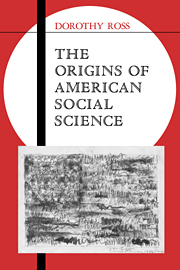Book contents
- Frontmatter
- Contents
- Acknowledgments
- Abbreviations used in the footnotes
- Introduction
- Part I European social science in antebellum America
- Part II The crisis of American exceptionalism, 1865–1896
- Part III Progressive social science, 1896–1914
- 5 The liberal revision of American exceptionalism
- 6 Marginalism and historicism in economics
- 7 Toward a sociology of social control
- 8 From historico-politics to political science
- Part IV American social science as the study of natural process, 1908–1929
- Epilogue
- Bibliographical note
- Indexes
- Ideas in Context
7 - Toward a sociology of social control
Published online by Cambridge University Press: 23 September 2009
- Frontmatter
- Contents
- Acknowledgments
- Abbreviations used in the footnotes
- Introduction
- Part I European social science in antebellum America
- Part II The crisis of American exceptionalism, 1865–1896
- Part III Progressive social science, 1896–1914
- 5 The liberal revision of American exceptionalism
- 6 Marginalism and historicism in economics
- 7 Toward a sociology of social control
- 8 From historico-politics to political science
- Part IV American social science as the study of natural process, 1908–1929
- Epilogue
- Bibliographical note
- Indexes
- Ideas in Context
Summary
In the summer of 1905 a sociological colleague of Lester Frank Ward's in Washington, D.C., suggested that the sociologists form their own professional organization. Everyone agreed with Edward A. Ross that an American Sociological Society would help “to clarify our minds, acquaint us with one another's opinions, and exalt the dignity of sociology in the public eye.” Deliberately adopting an ecumenical professional policy, the sociologists eschewed any ideological or theoretical affiliation and opened membership to social-work practitioners as well as academics, so long as they claimed a “scientific” interest in sociology. Ward was named the first president and his original rival, William Graham Sumner, the first vice-president and president-elect. Both Franklin Giddings and Albion Small took active roles in the proceedings. New converts to sociology, like Edward A. Ross and Charles Horton Cooley, were also present. As we have seen happen in economics, professional accommodation accompanied a substantive movement toward new liberal politics and the liberal exceptionalist vision of American history.
Professional convergence
The polar positions Ward and Sumner, then Small and Giddings had staked out in the Gilded Age shifted after the turn of the century to narrower ground. After Small abandoned the possibility of socialist transformation, all four envisioned the evolution of modern society, and America along with it, in liberal terms. The question now became how far that evolution was open to new liberal change.
- Type
- Chapter
- Information
- The Origins of American Social Science , pp. 219 - 256Publisher: Cambridge University PressPrint publication year: 1990



